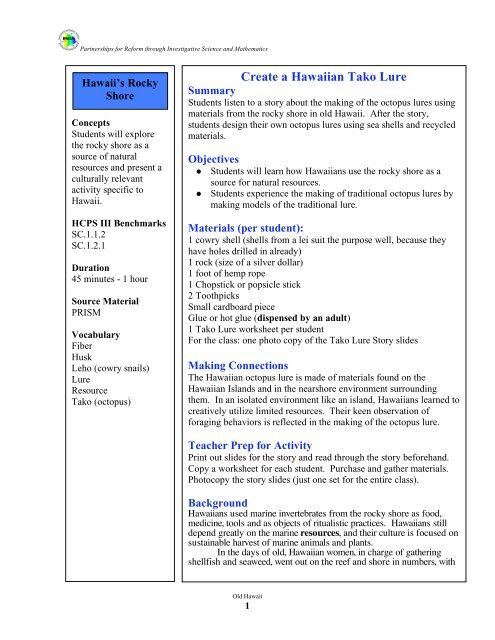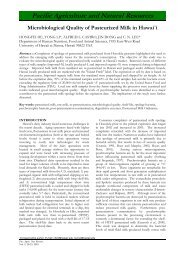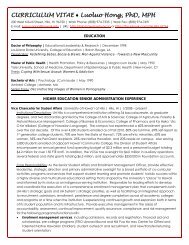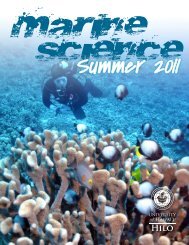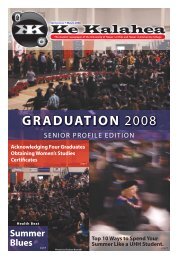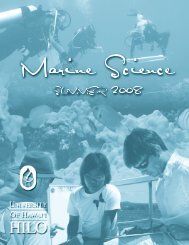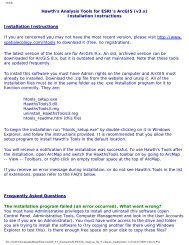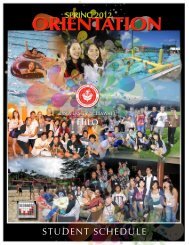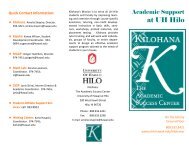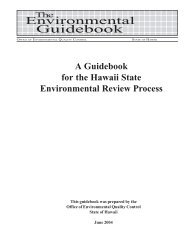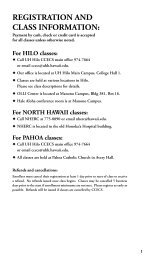Create a Hawaiian Tako Lure
Create a Hawaiian Tako Lure
Create a Hawaiian Tako Lure
You also want an ePaper? Increase the reach of your titles
YUMPU automatically turns print PDFs into web optimized ePapers that Google loves.
Partnerships for Reform through Investigative Science and Mathematics<br />
Hawaii’s Rocky<br />
Shore<br />
Concepts<br />
Students will explore<br />
the rocky shore as a<br />
source of natural<br />
resources and present a<br />
culturally relevant<br />
activity specific to<br />
Hawaii.<br />
HCPS III Benchmarks<br />
SC.1.1.2<br />
SC.1.2.1<br />
Duration<br />
45 minutes - 1 hour<br />
Source Material<br />
PRISM<br />
Vocabulary<br />
Fiber<br />
Husk<br />
Leho (cowry snails)<br />
<strong>Lure</strong><br />
Resource<br />
<strong>Tako</strong> (octopus)<br />
<strong>Create</strong> a <strong>Hawaiian</strong> <strong>Tako</strong> <strong>Lure</strong><br />
Summary<br />
Students listen to a story about the making of the octopus lures using<br />
materials from the rocky shore in old Hawaii. After the story,<br />
students design their own octopus lures using sea shells and recycled<br />
materials.<br />
Objectives<br />
Students will learn how <strong>Hawaiian</strong>s use the rocky shore as a<br />
source for natural resources.<br />
Students experience the making of traditional octopus lures by<br />
making models of the traditional lure.<br />
Materials (per student):<br />
1 cowry shell (shells from a lei suit the purpose well, because they<br />
have holes drilled in already)<br />
1 rock (size of a silver dollar)<br />
1 foot of hemp rope<br />
1 Chopstick or popsicle stick<br />
2 Toothpicks<br />
Small cardboard piece<br />
Glue or hot glue (dispensed by an adult)<br />
1 <strong>Tako</strong> <strong>Lure</strong> worksheet per student<br />
For the class: one photo copy of the <strong>Tako</strong> <strong>Lure</strong> Story slides<br />
Making Connections<br />
The <strong>Hawaiian</strong> octopus lure is made of materials found on the<br />
<strong>Hawaiian</strong> Islands and in the nearshore environment surrounding<br />
them. In an isolated environment like an island, <strong>Hawaiian</strong>s learned to<br />
creatively utilize limited resources. Their keen observation of<br />
foraging behaviors is reflected in the making of the octopus lure.<br />
Teacher Prep for Activity<br />
Print out slides for the story and read through the story beforehand.<br />
Copy a worksheet for each student. Purchase and gather materials.<br />
Photocopy the story slides (just one set for the entire class).<br />
Background<br />
<strong>Hawaiian</strong>s used marine invertebrates from the rocky shore as food,<br />
medicine, tools and as objects of ritualistic practices. <strong>Hawaiian</strong>s still<br />
depend greatly on the marine resources, and their culture is focused on<br />
sustainable harvest of marine animals and plants.<br />
In the days of old, <strong>Hawaiian</strong> women, in charge of gathering<br />
shellfish and seaweed, went out on the reef and shore in numbers, with<br />
Old Hawaii<br />
1
Partnerships for Reform through Investigative Science and Mathematics<br />
children searching along with them for edible things. Sponges, corals, and mollusks were among<br />
the many marine invertebrates that <strong>Hawaiian</strong>s collected for daily uses. “Ana”, a siliceous sponge,<br />
was used as medicine. <strong>Hawaiian</strong>s used many types of coral as medicine and abrasives (for cutting<br />
and sanding, e.g. polishing canoes). <strong>Hawaiian</strong>s enjoyed mollusks such as ‘opihi (limpet) as food<br />
items, and the shells of ‘opihi were used as tools for cutting and scraping. The shells from leho<br />
(cowry snails) were used as ornaments and tools, and the snails were consumed as food. Fiber<br />
from coconut husks were made into rope for lashing these tools together. <strong>Hawaiian</strong>s used leho as a<br />
tako (octopus) lure, which is the focus of this lesson.<br />
Procedure<br />
1. Introduce the new vocabulary words and write them on the ongoing Rocky Shores vocabulary<br />
chart paper.<br />
2. Gather students in a circle, so everyone can see the drawings you are holding. Explain the<br />
drawings by narrating a story.<br />
Slide 1: <strong>Hawaiian</strong>s used the plants and animals around them to survive. By living on islands,<br />
they were sure to use their resources carefully because once they were gone they could not be<br />
replaced. <strong>Hawaiian</strong>s made ropes using coconut husk. The fiber of coconut husk was extracted<br />
and braided by hand. The ropes were used in many things including canoes and fishing line.<br />
Slide 2: Using tools that were made from shells, <strong>Hawaiian</strong>s crafted fishing hooks from wood and<br />
mollusk shells.<br />
Slide 3: Cowries were collected from ocean and the shore. Cowries can be found in the intertidal<br />
zone, in tidepools and shallow rocky waters. Only the best cowries were used as bait, because an<br />
octopus (tako) only takes the best cowry. <strong>Hawaiian</strong>s believe that certain octopus caught using a<br />
cowry bait have high medicinal value.<br />
Slide 4: An octopus lure was made of three things: A rock to sink the lure, a cowry as the bait,<br />
and a hook to catch the octopus.<br />
Slide 5: We see that this <strong>Hawaiian</strong> man (kane) has caught an octopus. Octopus was usually<br />
salted, cooked and shared.<br />
3. Divide the class into groups of 4 students and distribute the worksheets. Tell students that they<br />
should complete the worksheet by working with their neighbors at their desks.<br />
• Where in the ocean can you find an octopus? (Probing question: What are the different<br />
tidal zones? Where have you seen an octopus?)<br />
• What does an octopus eat? ( Probing questions: Do you think they eat plants? Do you<br />
think they eat other animals? What kind of animals?)<br />
• What is the rock used for on the lure? (Probing questions: Does the shell sink or float by<br />
itself? What about when it is attached to a rock?)<br />
4. After answering the questions, students can start making the lures. Once the student is<br />
completed with the in-class portion of the worksheet (page 1 only), give him/her the materials<br />
for making a tako lure. Provide a demonstration of lure construction.<br />
5. Allow students 10 - 15 minutes to construct a lure. If students have trouble tying knots, circle<br />
the room assisting with knots. Have students come to a station where the rock will be glued to<br />
the stick (only the teacher should distribute the hot glue for the rock).<br />
6. Before ending the class, have volunteers present their octopus lure to the class. Ask questions<br />
about making the lure as well as sustainability questions, such as:<br />
Old Hawaii<br />
2
Partnerships for Reform through Investigative Science and Mathematics<br />
What was difficult about making the lure?<br />
How will the lure work in the ocean to catch the tako?<br />
Why is the rock important?<br />
Why will the tako be attracted to the lure?<br />
What would happen if <strong>Hawaiian</strong>s could not find any cowries?<br />
Why is it important to protect your resources?<br />
7. Encourage students to explain each part of the lure to their family when they bring their lures<br />
home. Place each lure in a small plastic bag with a piece of paper reminding them to tell their<br />
family about the lure. For homework, assign the second page of the worksheet, where they<br />
draw their lure and label its parts.<br />
Assessments<br />
Making a model of the octopus lure<br />
Completing the work sheet and homework<br />
Resources<br />
Titcomb, Margaret.1979. Native Use of Marine Invertebrates in Old Hawaii. Pacific Science 32:<br />
325-377.<br />
Worksheet photos:<br />
• Octopus- http://www.malawicichlidhomepage.com/aquainfo/marinetank53.html<br />
• Cowry shell- http://www.nma.gov.au/cook/artefact.php?id=110<br />
Old Hawaii<br />
3
Partnerships for Reform through Investigative Science and Mathematics<br />
Design a tako lure!<br />
Student name_________________________<br />
Where in the ocean can you<br />
find an octopus?<br />
What does an octopus eat?<br />
What is the rock on the lure used for?<br />
- 1 -
Partnerships for Reform through Investigative Science and Mathematics<br />
Design a tako lure!<br />
Student name_________________________<br />
HOMEWORK:<br />
Draw your octopus lure, and label its parts.<br />
- 2 -
Making octopus lures<br />
(in old Hawaii)
Coconuts<br />
Rope
Cowry
<strong>Tako</strong> (octopus) lure<br />
Rope<br />
Rock<br />
Cowry<br />
snails<br />
Hook


